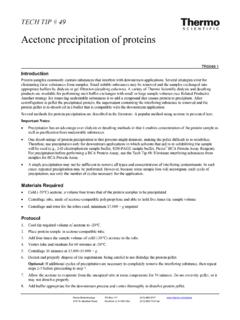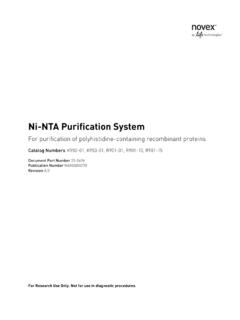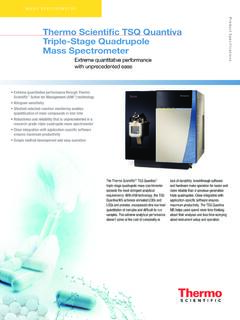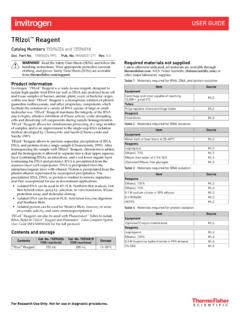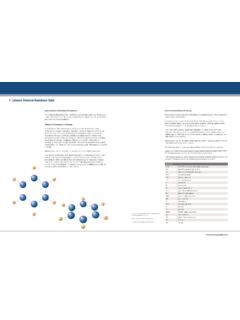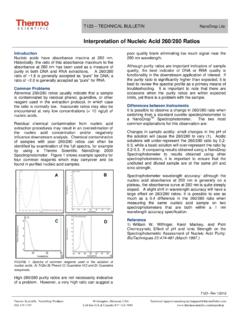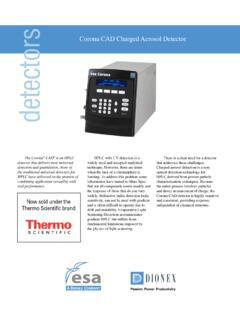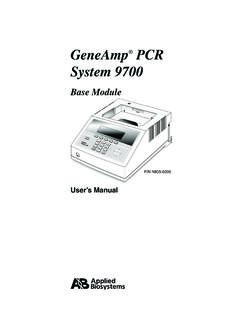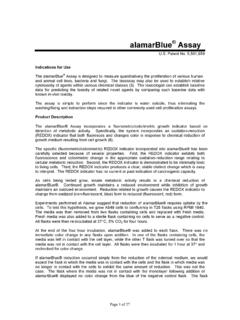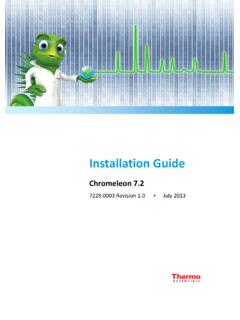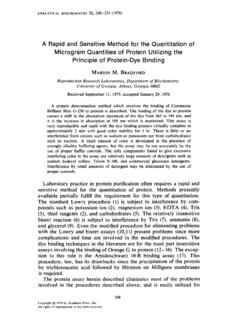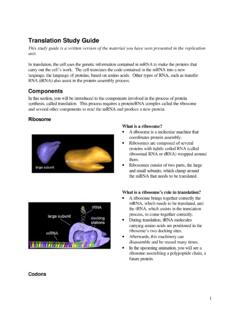Transcription of Protein A Affinity Column for Monoclonal Antibody (MAb ...
1 Protein A Affinity Column for Monoclonal Antibody (MAb) Titer AnalysisShanhua Lin, Kelly Flook, Yuanxue Hou, Hongmin Zhang, Charanjit Saini, Srinivasa Rao, Yury Agroskin, and Chris Pohl Thermo Fisher Scientific, Sunnyvale, CA, USA2 Protein A Af nity Column for Monoclonal Antibody (MAb) Titer AnalysisResults Staphylococcal Protein A (SPA) plays an important role in immunology and biochemistry owing to its specific interaction with the Fc part of immunoglobulin G (IgG) from many mammals. SPA is a cell wall associated Protein domain exposed on the surface of the Gram-positive bacterium, Staphylococcus aureus. SPA consists of three different regions; S, being the signal sequence that is processed during secretion, five homologous IgG binding domains E, D, A, B, and C, and a cell-wall anchoring region XM. SPA and the smaller ligands derived from SPA have been used widely for the Affinity purification of Recombinant Protein A (rSPA), is expressed in E.
2 Coli as opposed to the native Protein extracted from Staphylococcus aureus. rSPA is a 45 kDa Protein containing the same amino acid sequence and molecular mass as the native Protein A sourced from S. aureus. rSPA is used as the Affinity ligand for the MAbPac Protein A Column . Conclusions The MAbPac Protein A Column has a dynamic loading capacity of at least 100 g. It is capable of quantifying MAbs in the range of mg/mL to 5 mg/mL. The MAbPac Protein A Column has a fast cycle time. At 2 mL/min, a complete titer analysis takes 2 min. The MAbPac Protein A Column has been successfully tested through 2,000 cycles without loss of binding capacity. References 1. Hober, S., Nord, K., and Linhult, M. Protein A Chromatography for Antibody Purification. Journal of Chromatography B, 848 (2007) 40 47. Overview Purpose: Demonstrate the capability of a Thermo Scientific MAbPac Protein A Column for titer analysis of Monoclonal antibodies (MAb).
3 Methods: The MAbPac Protein A Column has been analyzed on a Biocompatible HPLC system. Chromatographic conditions such as flow rate, Column temperature, and sample loadings were tested to evaluate the Column performance. Results: The MAbPac Protein A Column can accurately determine the MAb titer in the range of mg/mL to 5 mg/mL. The total analysis time is less than 2 minutes. Introduction Early in the development of recombinant Monoclonal antibodies (MAbs), a large number of harvest cell culture (HCC) samples must be screened for IgG titer. Affinity chromatography employing a Protein A ligand is often used to determine the MAb concentration as well as to purify it for downstream aggregate and charge variant analysis. The challenge facing the analytical laboratories in the pharmaceutical industry is to develop high-throughput and robust titer assay. In the current study, we are presenting a Protein A Column for fast MAb titer analysis.
4 The Column is developed based on a novel polymeric resin. The hydrophilic surface is designed to accommodate Protein conjugation. A recombinant Protein A ligand is covalently attached onto the hydrophilic resin surface. The functionalized resin with recombinant Protein A is then packed into a 4 35 mm PEEK Column body. The hydrophilic nature of the backbone minimizes non-specific binding and therefore enables accurate quantification of the MAb titer. In addition, the non porous particle produces a highly efficient Column at high flow rates. When injecting 20 g of rabbit IgG, the IgG peak width at half height is about min. The sharp peak shape also provides great sensitivity. As little as g of MAb can be easily detected. The Protein A Column has very low back pressure and this allows high flow rate for fast analysis. At mL/min, the entire analysis, including equilibration, takes only min.
5 Ruggedness testing shows that this Column can go through more than 2,000 cycles with very little loss of performance. The HPLC compatibility of this Column allows automation, provides accurate and high throughput analysis. Methods Sample Preparation Monoclonal Antibody harvest cell culture was a gift from a local biotech company. The HCC was filtered through a m membrane prior to sample injection. Columns MAbPac Protein A Column , 12 m, 4 35 mm Buffers Eluent A: 50mM Sodium Phosphate, 150 mM NaCl, 5% acetonitrile, pH Eluent B: 50mM Sodium Phosphate, 150 mM NaCl, 5% acetonitrile, pH Liquid Chromatography HPLC experiments were carried out using an hybrid system equipped with: Thermo Scientific Dionex ICS-3000 Dual Gradient Pump System Thermo Scientific Dionex TCC-100 Column Compartment Thermo Scientific WPS-3000 Pull-Loop AutoSampler Thermo Scientific Dionex VWD-3400RS UV Detector equipped with a L Micro Flow Cell 20 g rabbit IgG was injected every 100 cycles over the course of 2,000 runs, see Figure 6.
6 Retention time, peak area, and peak width of IgG from each chromatographic run are listed on the inserted table. FIGURE 1. Schematic of an Antibody showing the fragment crystallizable region (Fc) and the fragment antigen binding region. PEEK is a trademark of Victrex Inc. All other trademarks are the property of Thermo Fisher Scientific and its subsidiaries. This information is not intended to encourage use of these products in any manner that might infringe the intellectual property rights of others. PO20806_E 05/13S Protein A Affinity Column for Monoclonal Antibody (MAb) Titer Analysis Shanhua Lin, Kelly Flook, Yuanxue Hou, Hongmin Zhang, Charanjit Saini, Srinivasa Rao, Yury Agroskin, and Chris Pohl, Thermo Fisher Scientific, Sunnyvale, CA, USA Fab Fab Fc light chain heavy chain Disulfide bonds variable region constant region Dynamic loading capacity The dynamic loading capacity of rabbit IgG, isolated from pooled normal serum, is no less than 100 g on the MAbPac Protein A Column , analyzed at a flow rate of 2 mL/min.
7 Figure 2 shows the linearity of area to sample load for rabbit IgG when loaded onto the MAbPac Protein A Column . This correlation allows the MAbPac Protein A Column to be used for quantitation of MAb in harvest cell culture over a wide range of concentrations. FIGURE 2. Area dependence on rabbit IgG Loading. Gradient: 0% B for mins, 100% B for mins, 0% B for mins. FIGURE 3. Effect of flow rate on IgG binding . Influence of flow rate on Column pressure, cycle time and peak area The MAbPac Protein A Column can be used at a flow rate up to mL/min. The recommended flow rate is 2 mL/min. Figure 4 shows the effect on increasing flow rate on Column backpressure. Figure 3 shows that as you increase the flow rate there is little effect on the amount of IgG that binds to the Column . The increase in total area (Table 1) is due to the use of the same data collection rate of the detector. FIGURE 4. Example of effect of flow rate on Column backpressure.
8 TABLE 1. Effect of Flow Rate on IgG peak area. FIGURE 5. Temperature effect on binding efficiency. Influence of temperature on binding efficiency It is recommended to use the MAbPac Protein A Column at temperatures no higher than 35 C. To ensure data consistency and to prolong the Column life time, it is recommended to use a Column oven to control the temperature to 25 C. Figure 5 shows how rabbit IgG binding is minimally affected by temperature. Proteins with different binding association may be affected differently. Column Ruggedness The MAbPac Protein A Column has been tested continuously for 2,000 cycles. Every hundred cycles, a set of calibration standards (from mg/mL to 5 mg/mL) was analyzed. As shown in Figure 6, the retention time, peak area, and peak width of IgG remain unchanged. In the upper range, there is no loss of binding capacity and in the lower range sensitivity is maintained.
9 FIGURE 6. Chromatograms of rabbit IgG analyzed on the MAbPac Protein A Column . R = 0 10 20 30 40 50 60 0 20 40 60 80 100 120 Area, Amount rabblit IgG, g 0 700 0 700 0 700 0 700 0 1 2 3 4 5 6 7 8 0 700 mL/min 0%B for mins, 100% B for mins, 0%B for mins Column : MAbPac Protein A, 4 35 mm Gradient: Adjusted according to flow rate Temperature: 25 C Detection: 280 nm Inj. Volume: 20 L Sample: Rabbit IgG, 1 mg/mL Minutes mAu mL/min 0%B for mins, 100% B for mins, 0%B for mins mL/min 0%B for mins, 100% B for mins, 0%B for mins mL/min 0%B for mins, 100% B for mins, 0%B for mins mL/min 0%B for mins, 100% B for mins, 0%B for mins 35 C 30 C 25 C 20 C 15 C Minutes mAu -300 -200 -100 0 100 200 300 400 500 600 700 800 Column : MAbPac Protein A, 4 35 mm Flow rate: 2 mL/min Gradient: 0% B for mins, 100% B for mins, 0%B for mins Detection: 280 nm Inj.
10 Volume: 20 L Sample: Rabbit IgG, 1 mg/mL -50 200 400 600 800 1,000 1,200 1,400 #2011 #1811 #1611 #1411 #1211 #1011 #811 #611 #411 #211 #30 Column : MAbPac Protein A, 4 35 mm Flow rate: 2 mL/min Gradient: 0%B for mins, 100% B for mins, 0%B for mins Temperature: 25 C Detection: 280 nm Inj. volume: 20 L Sample: Rabbit IgG, 1 mg/mL mAu Minutes Run # (min)Area (mAu*min)PWHH (min) 50 100 150 200 250 300 350 400 Column Pressure (Psi) Flow Rate (mL/min) Column : MAbPac Protein A, 4 35 mm Temperature: 25 C Column : MAbPac Protein A, 4 35 mm Flow rate: 2 mL/min Gradient: 0%B for mins, 100% B for mins, 0%B for mins Detection: 280 nm Temperature: 25 C Inj. volume: 20 L Sample: Rabbit IgG Flow Rate (mL/min) Total Area ( ) Unbound Area ( ) Unbound Relative Area, % IgG Area ( ) IgG Relative Area, % 3 Thermo Scienti c Poster Note PN20806_E 06/13S Results Staphylococcal Protein A (SPA) plays an important role in immunology and biochemistry owing to its specific interaction with the Fc part of immunoglobulin G (IgG) from many mammals.
